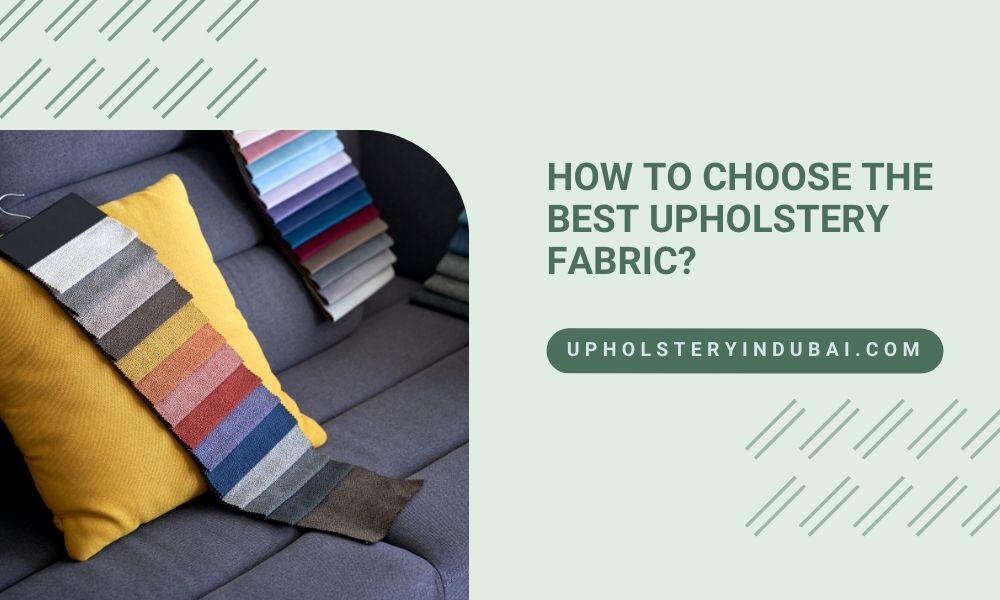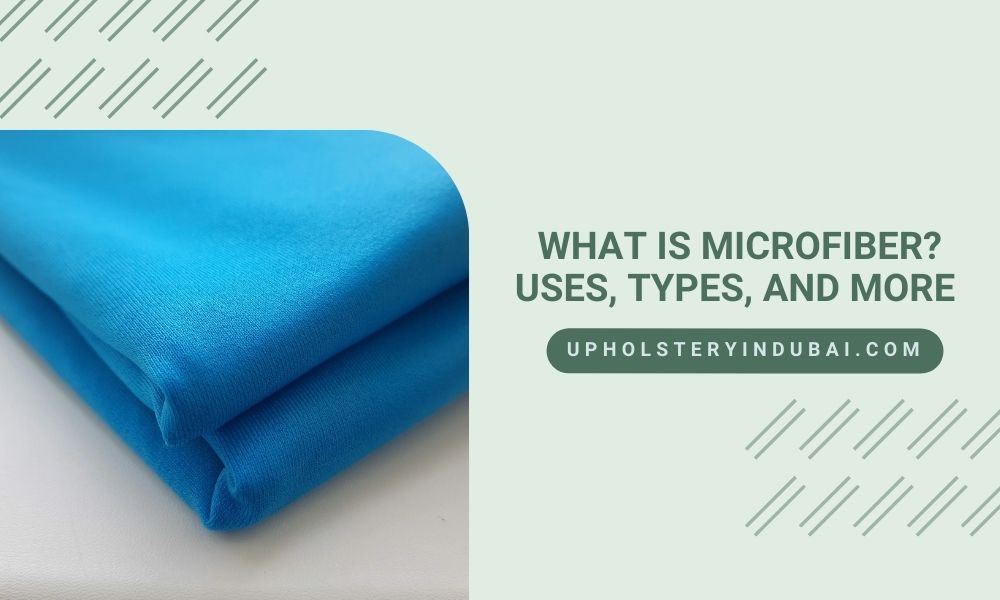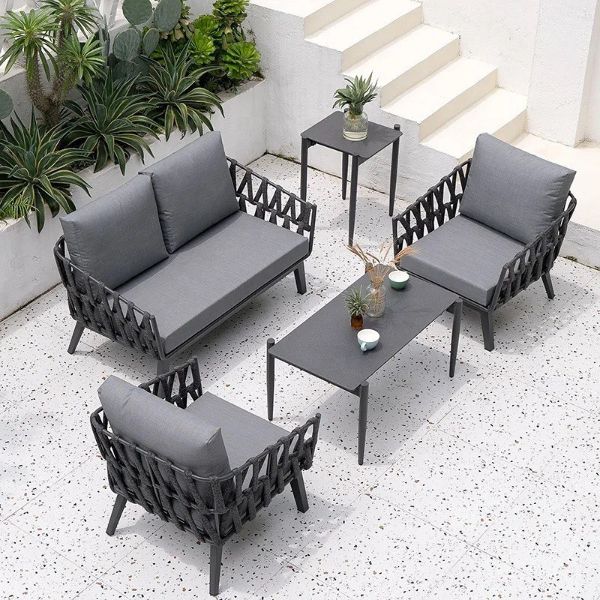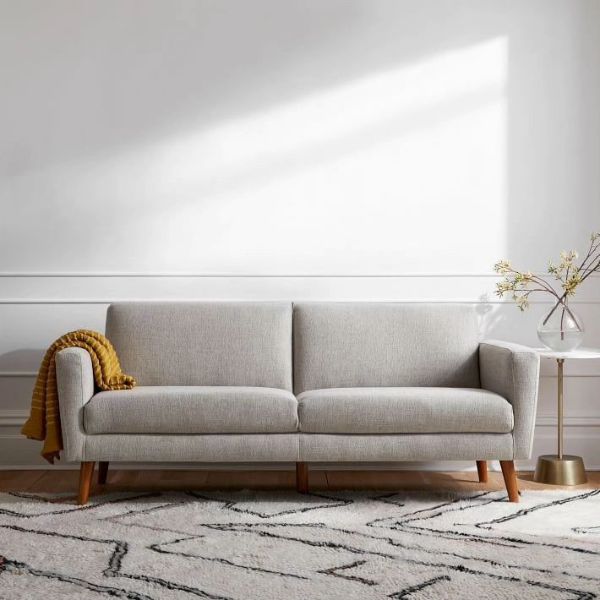Furniture style, comfort, and longevity all heavily depend upon the upholstery fabric used. This fabric is used to cover the wooden frames of couches, chairs, and other pieces of seating. The appearance of your furniture can be improved, it’s usage intensity can be resisted, and it can offer years of relaxation with the correct choice of upholstery material(s). At Upholstery in Dubai, we will go over the significance of upholstery fabric in this article and provide specific techniques for picking the finest ones for your requirements.

Why Upholstery Fabric Is Important For Your Space?
Aesthetics
Upholstery fabric is an important component of home design because it affects how a room looks and feels overall. The fabric colors, patterns, and textures can determine how the room feels as a whole.
Comfort
The comfort of your furniture can be significantly impacted by the fabric you choose. While synthetic blends offer a smoother, sleeker texture, softer, more breathable materials like cotton and linen offer a comfortable and welcoming feel.
Durability
Your furniture’s first line of protection against normal wear and tear is its upholstery fabric. It must be resilient enough to endure constant use, friction, and spills without developing too many ageing symptoms. Your furniture will last for years in good condition if you choose strong fabric for upholstery.
Protection Of The Furniture Frame
Upholstery fabric shields the inner structure of furniture from damage, scuffs, and dirt. It increases the furniture’s longevity by maintaining it’s stability and shape.
Versatility
Sofas, chairs, headboards, and other forms of furniture can all be upholstered using upholstery fabric since it is so adaptable. Its adaptability enables you to harmonize the appearance of your furniture across many areas.
Expression Of Personal Style
You can express your own sense of style and aesthetics with the upholstery fabric you choose. You can choose the ideal fabric that compliments your design preferences from a wide variety of colors, patterns, and textures that are readily available.
Practicality And Maintenance
Upholstery textiles have various useful qualities like stain and fade resistance and ease of washing. These characteristics lengthen the life of the furniture making upkeep easier to handle.
Factors To Consider When Choosing The Appropriate Upholstery Fabric
Although selecting the right upholstery might be difficult, making an informed choice can lead to furniture purchase that suits your needs and tastes well. When choosing the ideal fabric, consider the following steps:
1. Usage And Location
Establish the location and frequency of use for the upholstered furniture. While less-used locations, such as formal sitting rooms or bedrooms can tolerate more delicate alternatives, high-traffic areas like living rooms and family rooms call for more robust materials.
2. Longevity
Durability is one of the most important considerations when choosing upholstery fabric. Look for the rub count, which evaluates the fabric’s resistance to abrasion, to get an idea of this. Martindale and Wyzenbeek are the two most widely used rub tests. Better durability is indicated by a greater rub count. A rub count of 15,000 or more is advised for high-traffic areas, while 9,000–15,000 is suitable for lesser-traffic areas.
3. Type of The Fabric
Think about the fabric kind that best meets your demands. Every fabric type has a unique set of qualities:
-
Natural Fabrics
Comfortable and breathable materials include cotton, linen, wool, and silk. While linen feels beautiful, cotton is strong and simple to clean. However, natural textiles could be more prone to fading, staining, and wrinkling.
-
Synthetic Fabrics
Natural fabrics are typically less resilient to stains and are less durable than polyester, nylon, and acrylic. For busy houses with children and dogs, they are a sensible option. Moreover, a variety of hues and patterns are available in synthetic textiles.
-
Blends
The best characteristics of both types of fibers can be used in a blend to create fabrics that are more enduring and wrinkle-resistant.
4. Color And Pattern
Take into account the room’s existing color scheme and decor before placing any furniture there. Opt for a color and design that goes well with or improves the room. Vibrant patterns might draw attention, whilst neutral tones offer greater styling flexibility.
5. Stain Resistance
Choose textiles with a stain-resistant finish if the furniture will be placed in areas where spills or stains are likely to occur. Since these textiles have been treated to resist liquid, cleanup is simpler and stains are less likely to appear.
6. Fade Resistance
Use textiles that won’t fade if your furniture will be in direct sunlight to keep the colors brilliant and fresh for a longer period of time.
7. Texture Of The Fabric
The overall appearance of the furniture and the room can be greatly influenced by the fabric’s texture. To achieve the look you want, think about whether you prefer a smooth, rough, or patterned texture.
8. Cleaning And Maintenance
For cleaning and upkeep advice, consult the manufacturer. While certain materials can be spot cleaned at home, others might need expert cleaning. Choose a fabric for which you are willing to spend the time and effort required to keep it looking good.
9. Allergies
Think about upholstery textiles that are hypoallergenic and less likely to trap dust and allergens if anyone in your home has allergies or sensitivities.
10. Budget
Establish a budget for the upholstery fabric because costs might differ greatly depending on the type and caliber of the material. Keep in mind that buying more expensive, long-lasting textiles will save you money in the long term because they won’t need to be replaced as frequently.
11. Test And Sample
Get a sample of the fabric and try it at home whenever feasible. Examine how it appears in various lighting situations, how it feels to the touch, and how it blends in with the current decor.
12. Upholstery Style
The selection of the best fabric is also influenced by the design of the furniture. Modern furniture can benefit from vivid, current fabrics, while traditional pieces usually pair well with classic patterns. Before making your decision, take into account the furniture’s general architecture and design.
13. Fire Retardant
You might want to select fire-retardant materials, especially for public settings, depending on your local laws and safety concerns.
Winding Up
Finally, selecting the ideal upholstery fabric is a big decision that includes taking into account a variety of criteria like durability, style, comfort, and maintenance. You can choose a fabric that enhances the looks of your furniture, withstand daily usage, and provides comfort for years to come by carefully considering your needs and preferences. Take your time researching and comparing various materials, and if you are still confused seek guidance from upholstery professionals or interior designers to make an informed decision that fits your lifestyle and design goals.








